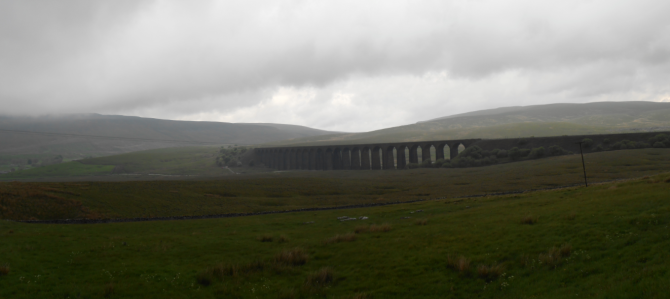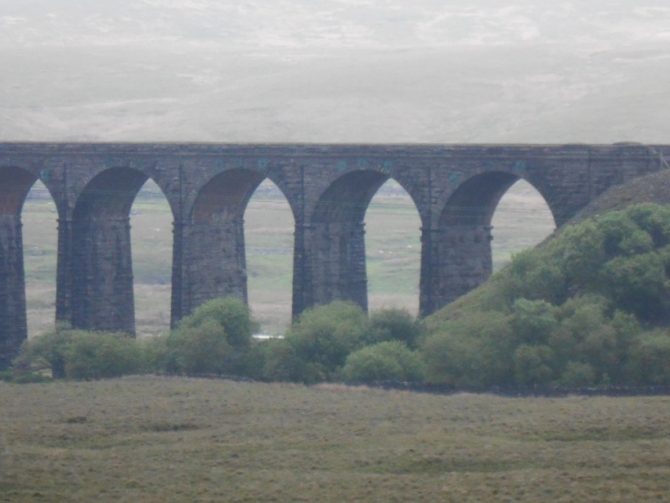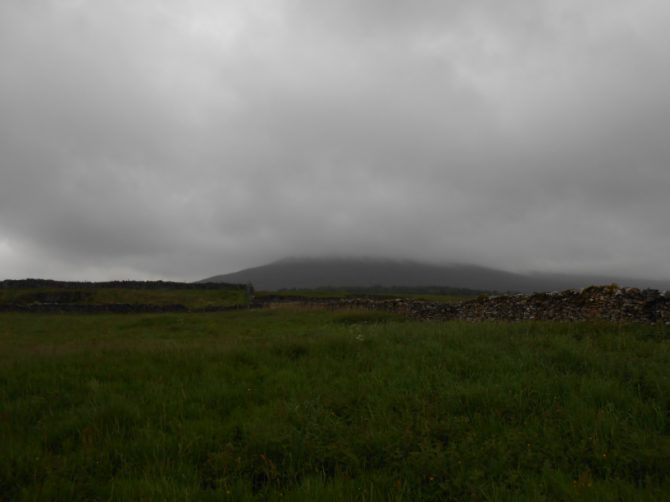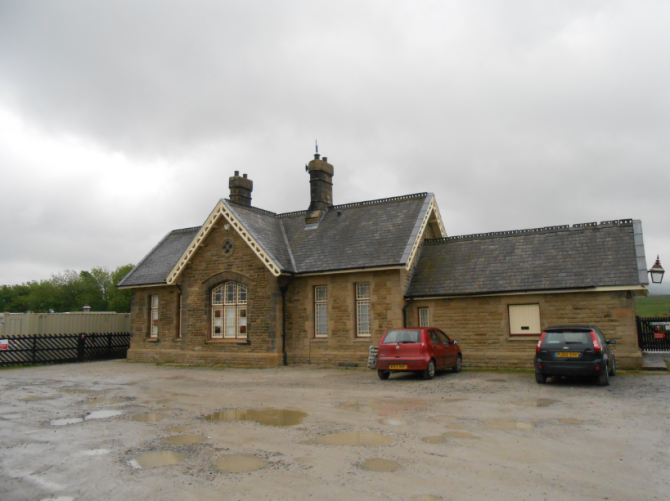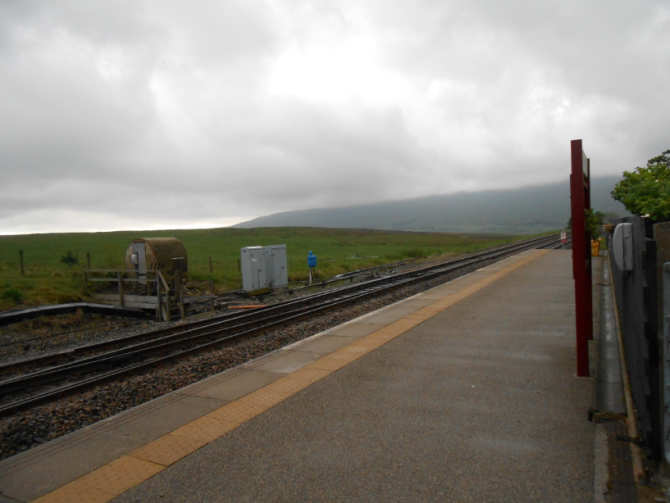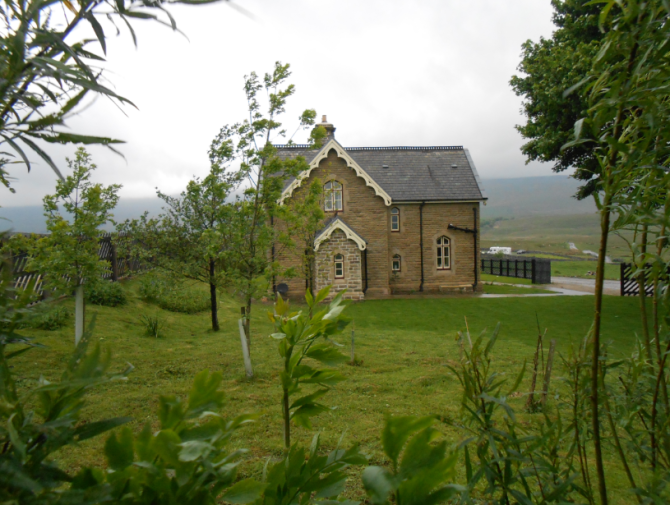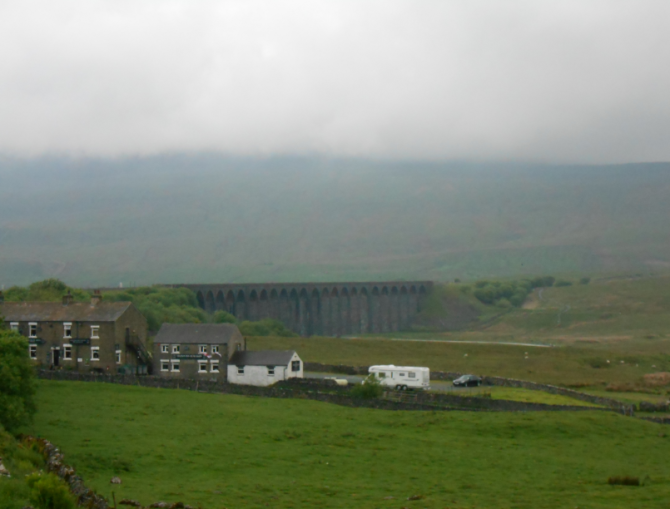Our last stop of the day was to the famous Ribblehead Viaduct, in the beautiful Yorkshire Dales. It lies on the Settle to Carlisle Line, and there is even a train station just South of the Viaduct for visitors, so we set out to explore both.
Our journey from Kendal took us briefly through Lancashire, and then into North Yorkshire where we entered the Yorkshire Dales National Park, our second National Park of the day. The road twisted and turned through the valleys and eventually, the Viaduct loomed in the horizon, out of the clouds.
We pulled up in a layby at the side of the road, overlooking the Viaduct, and trudged through a nearby field to get the best view. Thankfully the panoramic I attempted came out quite well, and you can see it above. It’s a marvel of Engineering, going back to 1870 after it had been designed by John Sydney Crossley, a well known Engineer. It took 1000 workers to build it, and they lived with their families in special towns, almost shanty towns, along the route.
The final stone was laid in 1874, with the 24 enormous arches, made from 1.5 million bricks, at last complete. Each arch has a span of 45 feet, with foundations running 25 feet below them.
On the train between Carlisle and Preston, we have often passed the Smardale Viaduct, another Viaduct between here and Carlisle, although it’s not on the actual Settle Line and is no longer used for rail traffic. Find out more in my post covering the subject here.
The Arches are very impressive, and the workmanship is a triumph of Engineering. The North End is 13 feet higher than the South End due to the geography of the valleys, with this particular valley being called Batty Moss. The whole structure is 0.25 (400 m) long, and although the whole line is 73 miles it is probably the most famous section of it.
There is only one single track crossing the Viaduct, to minimise damage caused by passing trains, which are also restricted to 20 mph as they cross. The line becomes double track again on either side of the Viaduct.
The Viaduct, and indeed the whole lines rural location makes it one of the most beautiful train journeys in England, starting in the border city of Carlisle up in Scotland, and passing down the length of Cumbria before entering Yorkshire, and ending in the town of Settle. Most services from Carlisle do run through from Settle to the city of Leeds in West Yorkshire, providing vital North/South connections.
The Yorkshire Dales is the second largest National Park in England, after only the Lake District. It was formed in 1954, and is one of fifteen National Parks across Britain. Recently an extension to the park has been agreed which will see over 100 square miles added onto the existing 683 square miles, and it will cover the area North and South of the present border near the M6, and the borders of the Lake District will also be expanded to include Borrowdale, making the Lake District and the Yorkshire Dales contiguous. It’s an exciting plan and I can’t wait for it to be fully implemented. This will also mean the border will fall over the current administrative county of Lancashire, in the City of Lancaster district.
Notable towns located just on the outside of the Yorkshire Dales include Skipton and Harrogate, whilst towns including Hawes and Sedbergh inhabit the interior.
We moved our attention to the train station and pulled into the Car Park. Trains are few and far between out here, with only around 5 each way a day, so instead of waiting for one to come through we just had a look around the building.
The Station has the same name as the Viaduct, the Ribblehead, as the Ribble Ribble begins very close to here, and runs South towards Settle before heading in a South-Westerly direction into Lancashire through Clitheroe, Ribchester, Preston and finally out into the Irish Sea 75 miles from it’s start point, next to my home village of Banks.
The Station opened in the 1870’s, and the line was very prosperous until there were plans to close it by the 1970’s, and the station was closed in 1970. It reopened 1983, although with only one platform as the other was knocked down to create a siding. A new platform was eventually added, although its further South than the original platform so it’s out of shot behind the camera. Inside is a Visitor Centre and Gift Shop, telling the story of the line and how close it came to being closed permanently. One of the contributing factors to this was the West Coast Main Line, as a lot of freight was transferred over to it, meaning there was less traffic along the line. A lot of the Viaducts and Tunnels were in a dilapidated state and there were only a few passenger trains a day, with high costs to refurbish them. By 1984 all the Stations were earmarked for closure however the local authorities the line ran through and served as well as enthusiasts banded together and forced British Rail to reconsider and reopen the line.
The Station was closed when we visited and it was getting quite late in the day, and we had enjoyed the small shop at Appleby Train Station, also on the line.
As we left, to head back towards Carlisle and home there was one last building that caught my eye. The Old Station Masters House is located on the approach to the Station. It was built in 1876 by the Midland Railway Company, and restored between 2006 and 2013 along with the rest of the line. It reopened in 2013, and its actually available to rent for up to 14 nights, and can hold at least 4 people. Visit the Settle & Carlisle Railway Trust site to find out more here.
Our last view of the Viaduct was from the road up to the station, and as we waved goodbye to this beautiful landmark, we had reached the end of another road trip, and made our way home, having visited some incredible towns (Keswick, Grasmere, Ambleside, Bowness & Kendal) and enjoyed the fantastic scenery of two National Parks.

